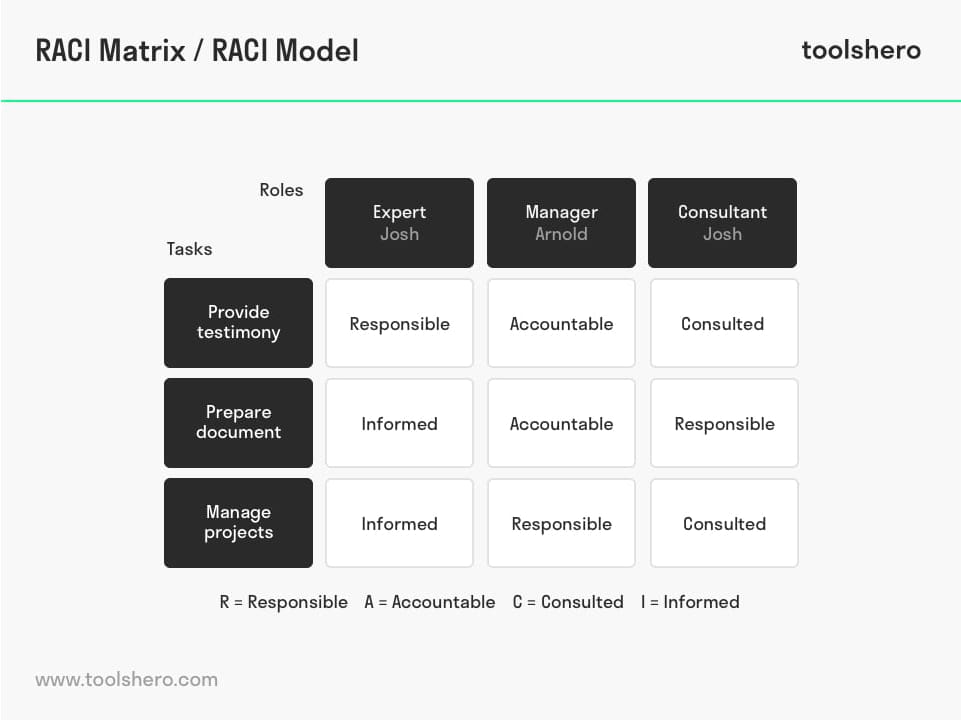RACI Matrix Theory: Example and Template

RACI Matrix Theory: this article explains the RACI Matrix in a practical way. Next to what it is (definition and meaning), this article also highlights a RACI Matrix example with defined roles, The aconym explained, addition on the acronym, steps to set-up a Matrix, the Focus areas, the combination with change management, general tips and a RACI Matrix template to get started! Enjoy reading!
What is RACI Matrix?
RACI Matrix definition and meaning
The RACI Matrix or RACI chart can be used to have good insight into the various participants of the project and their individual responsibilities during a (complex) project.
RACI is an acronym of Responsible, Accountable, Consulted and Informed. These terms are clarified later in this article. The matrix design of the RACI Matrix describes the participation of the various functional roles in the project or business process, in completing tasks or results.
The RACI Matrix is also referred to as Responsibility Assignment Matrix (RAM) or Linear Responsibility Chart (LRC).
This powerful solution is often used with PRINCE2 project management and the LEAN method.
RACI Matrix example layout defined roles
The RACI Matrix has a fixed layout with a horizontal axis of roles and a vertical axis with tasks, activities, deliverables and responsibilities. A distinction must be made between a role and individual people. A role is a description of a set of tasks.
These tasks may be performed by various people. Vice versa, a single person may have different roles. For example, an organisation may have ten employees who can perform the role of project manager and one person can perform the role of project manager and business analyst. Usually, certain roles are appointed to subject matter experts.

Figure 1 – The Elements of the RACI Matrix
What is RACI?
The RACI Matrix has a fixed design, with the names of functional roles on the horizontal axis and the various tasks, activities, the achievements to be delivered and responsibilities on the vertical axis. We must distinguish between a functional role and individual people.
A functional role is a description of a wide range of tasks or deliverables. Such a role can be carried out by multiple people. Conversely, an individual person may fulfil various different roles.
For instance, ten employees can fulfil the role of project manager within an organisation, and a single individual can fulfil the role of project manager and business analyst. RACI is an acronym of four important characteristics involved in a project:
Responsible
Responsible: the person carrying out the task is responsible for the execution. Subsequently, the executor must provide justification to the ‘Accountable’ person.
Accountable
Accountable: this person bears final responsibility for the correct completion of one or multiple project tasks. Others are accountable to him or her and he or she must approve the task (sign off). It’s possible that an ‘Accountable’ is appointed per task.
Consulted
Consulted: this is the person who is consulted beforehand. This is a two-way street; in addition to giving advice, he or she also helps in the execution and steers the result.
Informed
Informed: this person is kept informed with up-to-date information about the progress and achieved results. This is a one-way street.
Exception
It’s often the case that the role of Accountable is not part of the RACI Matrix. In that case, it is assumed this characteristic is joined with that of Responsible. However, apart from this exception, we recommend appointing each characteristic to only one person in the project. When a person falls under multiple characteristics, this could create stagnation in the project because it hinders the completion of specific tasks.
Addition to the RACI Matrix
Sometimes, the ‘S’ (RASCI) or ‘O’ (CAIRO) is added to the RACI model. The ‘S’ stands for Support; someone who supports and motivates team members to carry on in the project.
The ‘O’ stands for Out of the Loop; the one who’s standing at the sidelines and isn’t part of the process. This includes facilitating and supporting employees and/or departments.
Step-by-step plan filling in the RACI Matrix
Below, we discuss several steps that the user must follow to develop his own RACI Matrix. A toolshero template is available for this purpose.
Follow each step below to complete the template.
Step 1: identify different team members
It’s important to keep track of exactly who will be working on a certain task or project. Examples are the sponsor, project manager, team members, analysts and more.
Use the names of these people when this makes sense. Sometimes, it is also possible to use the position titles or team names. However, when members see their names in the matrix, this promotes their engagement.
Step 2: identify important milestones
Just like every project starts with planning, this is also an important part of the RACI model.
Use the developed objectives from the project plan or sponsor’s requirements and note down exactly which milestones must be achieved to deliver the project on time. For instance, if a website is being built, milestones could be the first design, testing and approval by the client.
Step 3: fill in the matrix for each team member and for every task
After all information concerning milestones, team members and responsibilities has been collected, the matrix can be filled in using the right data.
Simple programmes, such as Microsoft Excel, can be used for this purpose. Other software can also be used.
Step 4: fill in the accompanying R, A, C or I for each field to indicate the role of each person for each task
It’s important that each team member is assigned a specific role, depending on the aspect of the RACI Matrix. In the case of the milestone of the website design, the team manager bears final responsibility for gaining approval.
In this case, the executive sponsor is accountable, and the developer must be kept informed of the result.
Step 5: discuss, analyse and evaluate
Discuss the filled-in RACI matrix with everyone of the project team, the sponsors, and all relevant stakeholders. For instance it is possible that the executive sponsor wants to be the one to meet the client to gain approval or discuss the requirements. Comply with this request.
Step 6: distribute copies
In addition to step 5, distribute copies of the RACI Matrix to everyone. Preferably do this by email and put up a copy in the joint workspace.
Focus areas RACI Matrix
To preserve the quality of the RACI Model, we advise looking at the most frequent mistakes and pitfalls in the development. Avoid these mistakes and pitfalls and make sure that the RACI Matrix is accurate and the project successful.
Too many details
A RACI Matrix is not the same thing as a project plan, or even a Project Initiation Document (PID).
Although it’s important to include roles and the division of tasks, it is not necessary to include details on the activities and responsibilities.
Do not include the daily, weekly and monthly schedule here. In case of confusion about the project or the activities, it’s time to distribute the original project plan among the team.
Don’t use the same matrix
A RACI Matrix template is easy to adjust, and it’s therefore tempting to use it again for standardisation.
Generally speaking, the project manager will keep the original matrix, but every project should have its own RACI matrix. That’s because each project is different and has a different complexity level. The milestones are also different and the team members may have changed, or the team may have been completely replaced.
Be consistent
The person who is accountable in the matrix must be able to contribute the decisive factor in every task appointed to them in the matrix. Deviating from established roles will lead to confusion and mistrust, and will reduce the power of the RACI Matrix.
Naturally, it’s important to be flexible as a team, but it’s important not to shift the responsibilities and roles around too much.
Minimise the number of columns in the RACI Matrix
Each task and each column in the RACI Matrix must allow for a clear responsibility and decision. For the sake of efficiency and effectiveness, do not include things like team meetings in the matrix.
When use a RACI matrix?
The RACI matrix can be used in nearly every project, but there are several situations when it’s advantageous that tasks require multiple sources, are carried out simultaneously, or when tasks are dependent on other tasks.
Additionally, the RACI Matrix is also helpful in non-project management situations. Always use this tool in the following project management situations:
- When decision making or approval processes could hinder the project.
- When conflicts arise about who has a certain task.
- When conflicts arise about who is accountable for a milestone or task.
- When the project load is not evenly divided.
- When project members are at their maximum output and new project team members must quickly be attracted.
This tool is also effective in a non-project management setting:
- Workload Analysis: identify overload.
- Reorganisation: make sure that important functions and processes are not overlooked if an organisation’s structure is reorganised.
- New employees: new employees can be easily and quickly informed of their new responsibilities and roles with the RACI matrix.
- Work orders: the RACI model creates flexibility in management situations. This provides the right balance between line and project responsibilities.
- Conflict resolution: the RACI model offers a forum for discussion and conflict resolution between team members or departments.
- Establishing the status quo: the output of the RACI Matrix is an easy but effective way of establishing the responsibilities and roles in an organisation.
Not every team is equal, and the same is true of different projects. The one team might excel at communication, the other is able to focus on their own tasks exceptionally well. Another team is small enough to take sufficient time to complete various tasks. In such cases, it’s not necessary to take an extra step with the RACI Matrix.
The RACI Matrix is often a part of project management software. This software allows users to track everything they need, from open tasks to task milestones and resource planning.
RACI Matrix and change management
Various organisational problems often arise when developing a RACI Matrix. This is because this tool connects three elements of roles and responsibilities
Role conception
Role conception refers to what people think their job is. This is often still unclear, despite years of experience. A RACI matrix helps to clarify this.
Role expectation
The role expectation means what others in the organisation think someone’s position entails and how it must be carried out.
Role behaviour
The role behaviour is what people actually do in fulfilling their work and responsibilities.
The RACI Matrix is a useful tool, but also a collective name for various types of problems.
Think carefully about the level of details, defining tasks and roles, and bring the model to a level that is both succinct and sensible. Naturally, it’s not important to include who is responsible for getting coffee.
It is important to stay focused on the original reason for developing the RACI Matrix.
Don’t spend too much time developing this tool. Although it’s an important tool, it is not sensible to spend many hours of scarce time on it.
Instead of creating the perfect matrix, stay realistic and understand that a project often turns out differently than planned.
Tips for filling in the template
- Make sure the matrix is useful. So, think carefully about how RACI will be used and why.
- Choose a model and understand the conditions and context.
- Make sure that only one role is marked as responsible.
- Have stakeholders provide input for the core project and milestones/ requirements
RACI Matrix template
Start visualizing what the tasks and responsibilities are of each team member with this ready to use RACI Matrix template.
Download the RACI Matrix template
This template is exclusively for our paying Toolshero members. Click here to see if a membership is something for you!It’s Your Turn
What do you think? What is your experience with the RACI Matrix? Can you use this information to create a RACI matrix? Do you recognize the practical explanation mentioned above or do have more tips? Do you recognize the need to effectively assign roles to people? What are success factors to manage stakeholders within a project? Do you define project roles and responsibilities with this tool?
Share your experience and knowledge in the comments box below.
More information
- Jacka, J. M., & Keller, P. J. (2009). Business process mapping: improving customer satisfaction. John Wiley and Sons.
- Kofman, A., Yaeli, A., Klinger, T., & Tarr, P. (2009, May). Roles, rights, and responsibilities: Better governance through decision rights automation. In Proceedings of the 2009 ICSE Workshop on Software Development Governance (pp. 9-14). IEEE Computer Society.
- Morgan, R. (2008). How to do RACI charting and analysis: a practical guide. Retrieved October, 1, 2010.
How to cite this article:
Janse, B. (2020). RACI Matrix. Retrieved [insert date] from Toolshero: https://www.toolshero.com/project-management/raci-matrix/
Original publication date: 06/14/2020 | Last update: 11/21/2023
Add a link to this page on your website:
<a href=”https://www.toolshero.com/project-management/raci-matrix/”>Toolshero: RACI Matrix</a>












